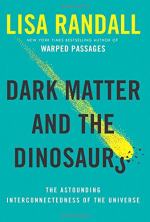|
This section contains 541 words (approx. 2 pages at 400 words per page) |

|
Summary
To illustrate the explosive potential and public fascination with meteor craters, Randall uses the kilometer-wide, privately-owned Barringer Crater in Arizona that hit the earth about 50,000 years ago with the force of a hydrogen bomb. That meteoroid was composed mostly of pure iron and nickel. Originally classified as a crater of volcanic origin by the U.S. Geological Survey, it was not until 1905 when it was recognized by the scientific establishment as extraterrestrial in origin. Its final confirmation came in 1960 when scientist Eugene Shoemaker noticed rare types of silica in the crater that could only have been made by either a nuclear explosion or high-impact meteoroid. This finding made plain the earth's link with the solar system and the cosmos, Randall writes.
She notes that high-impact meteoroids create tremendous stress on the earth's mantle and locally intense heating which can produce...
(read more from the Chapter 10 - Shock and Awe Summary)
|
This section contains 541 words (approx. 2 pages at 400 words per page) |

|




